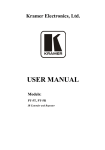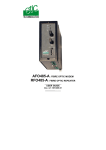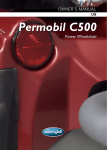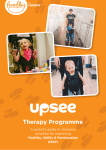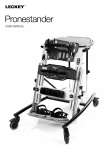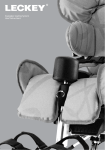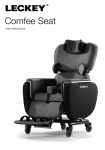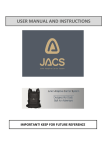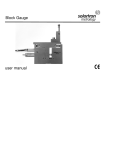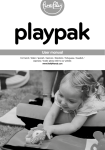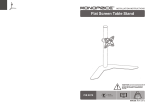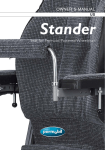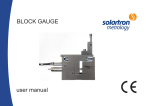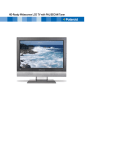Download Firefly Upsee
Transcript
User manual For French / Italian / Spanish / German / Mandarin / Portuguese / Swedish / Japanese / Arabic please refer to our website. www.fireflyfriends.com Please read all instructions carefully before using the Upsee. All instructions can also be found on our website www. fireflyfriends.com along with videos, diagrams and FAQ’s. Table of Contents 01 Intended Use 02 Declaration of Conformity 03 Terms of Warranty 04 Safety Information 05 Cleaning and Care Information 06 Daily Product Inspection & Servicing 07 Reissuing Firefly Products 08 Product Servicing 09 Instructions for Use: 5.1 Assessment and Prescription 5.2 Putting on your Upsee 5.3 Removing your Upsee 5.4 How to use your Upsee 10 Technical Table 11 Frequently Asked Questions SECTION 1. Intended Use The Upsee is an upright mobility device which enables an adult to facilitate standing and walking for young children from approximately 1 year to 8 years of age, who cannot stand or walk independently. The UpSee is a device that attaches to both parent/adult and child. It consists of 3 parts: Adult Belt (1 Size), Double Sandal (2 Size options although allocated according to child harness chosen) and Child Harness (4 Size options XSmall, Small, Medium & Large). The maximum user weight is XS - 15kg / 33lbs, Small – 15kg / 33lbs, Medium 20Kg / 44lbs and Large, 25kg / 55lbs. We would recommend the adult user carries out daily product inspections (according to Section 6 of this User Manual) to ensure safe use of the product. James Leckey Design Ltd cannot accept any responsibility if the product is used outside of its intended safe use. If in any doubt please contact Firefly Customer Services on UK 0800 318265 or ROI 1800 626020. SECTION 2. Declaration of Conformity James Leckey Design Ltd, as manufacturer with sole responsibility for the Firefly brand, declares that the Upsee conforms to the requirements of the 93/42/EEC Guidelines and EN12182 Technical Aids for Disabled Persons, General Requirements and Test Methods. SECTION 3. Terms of Warranty UK / ROI: Goods can be returned to us for warranty repair or replacement up to 12 months from receipt. Once you contact us we will arrange collection of the goods at our expense and, once returned to us we will repair or replace your goods and return them to you within 14 days. In all cases, it is the customer’s responsibility to ensure the goods being returned are suitably packaged, preferably in the original packaging. International Customers: Goods can be returned to us for warranty repair or replacement up to 12 months from receipt. Please contact us to obtain a case reference ID as per the International Returns procedure. The customer is responsible for the cost of returning the goods. Once returned to us we will repair or replace your goods and return them to you within 14 days. In all cases, it is the customer’s responsibility to ensure the goods being returned are suitably packaged, preferably in the original packaging. SECTION 4: Safety Information 1. Always read user instructions fully before use. 2. Check all components are securely fastened before use. 3. Do not modify the Upsee or use components other than Firefly approved components with your Upsee at any time. 4. Failure to follow the instructions may put you and/or your child at risk. 5. The Upsee should be stored carefully and should not be used if any parts are faulty. 6. Carry out any positional adjustments and ensure that all buckles, Velcro and press studs are fully fastened whilst seated. Do not make any adjustments to these while standing with your child. 7. The Upsee complies with fire safety regulations in accordance with EN1021-1. However the product should be kept away from naked flames. 8. Clean the product regularly in accordance with section 6 of this User Manual. Do not use abrasive cleaners. Carry out maintenance checks on a regular basis to ensure your product is in good working condition. 9. If in any doubt about the safe use of the Upsee or if any parts should fail, please cease using the product immediately and contact Firefly Customer Services on UK 0800 318265 or ROI 1800 626020. 10. Ensure the Adult belt is worn around the hips. Wearing the belt around the waist may cause back strain. 11. Recommended shoes while using the Upsee are trainers (sneakers) for safety and stability reasons. Shoes with heels, large boots, sandals or slippers should not be worn. 12. Ensure the four connecting straps on your adult belt are extended before attaching to your child’s harness and standing up. Loosen the straps again before sitting back down with your child. 13. Do not over tighten the straps as this will cause the child to hang in the harness, placing you at risk of back strain or losing balance. 14. Do not force movement – you could harm your child. The Upsee should only be used as a full kit and not be used as individual items. The kit including child harness, adult belt and double sandals have been designed to work together to provide maximum level of support, function and stability. We cannot guarantee safety of the child if individual items are used separately. SECTION 5: Cleaning and Care Information Child Harness and Adult Belt: - Upholstery can be placed into the washing machine after removing straps, buckles and fastenings. Store these in a safe place and out of reach of children. - Staining should be removed as quickly as possible with absorbent cloth, towels or a sponge. Routine soap and warm water sponging is effective for ordinary soiling and minor spills. Be careful not to saturate the fabric as this will cause the stain to spread. - Antiseptic cleaning agents can be used on more stubborn stains. These may require a safe solvent such as Isopropyl Alcohol or Mineral Spirit. Ensure that cleaning products are fully removed. - Do not bleach the product - While line drying is recommended, the child harness / adult belt can be tumble dried at a low temperature - You can use a warm iron on the Child Harness - Do not dry clean the Child Harness or Adult Belt Double Sandals - Sandals should be cleaned using a damp cloth only - Check tread on sole to ensure it doesn’t become clogged with dirt - Check Velcro on straps to ensure their function isn’t impaired by dirt or excess lint Sandals should not be machined washed. SECTION 6: DAILY PRODUCT INSPECTION We recommend that various checks or the Upsee are carried out before use to ensure the product is safe. The recommended checks are detailed below: - Check buckles and poppers are in place and secure - Check all upholstery for signs of wear and tear including Velcro strips - Check all webbing / straps are secure and there are no signs of wear or tear If in any doubt to the continued safe use of your Firefly product or if any parts should fail, please cease using the product and contact our customers services department as soon as possible. SECTION 7. Re-issuing Firefly Products Ensure the product has been cleaned thoroughly in accordance with section 5 of this manual. Ensure a copy of the user manual is supplied with the product. If in any doubt to the continued safe use of your Firefly product or if any parts should fail, please cease using the product and contact our customer service department as soon as possible on UK 0800 318265 or ROI 1800 626020. SECTION 8. Product Servicing Servicing of all Firefly products should only be carried out by technically competent persons who have been trained in the use of the product. This service is free of charge within the warranty period assuming the product has been used for the appropriate intended use. If the product falls outside of the warranty period, repairs will be chargeable. We may need to have the product returned to Firefly for further inspection which may incur a small fee for transportation. For all service related issues contact the Firefly customer service team on UK 0800 318265 or ROI 1800 626020. Section 9.1 Assessment and Prescription See videos online at www.fireflyfriends.com for further details. Before purchasing the Upsee you must be able to answer “yes” to three key questions. This helps us (and you) make sure the Upsee is suitable for your child. 1. Is your child already in a standing / walking programme? Your child’s participation in a physical therapy standing or walking programme ensures that your child has developed the necessary skills to get the most out of using their Upsee. If your child is not able to participate in a standing or walking programme, use of the Upsee is not recommended as it may cause discomfort or injury to them or you. If you are in any doubt about your child’s level of ability, please consult your physical therapist for advice. A 2. When standing, are your child’s shoulders below your navel / belly-button? If, when standing tall, your child’s shoulders are higher than your navel / belly-button, your child is too tall for you both to use the Upsee safely (a). The relationship of your child’s height to you is extremely important for your back care, as well as the stability and safety of you both. If a taller adult is not available to use the product with your child, it is not recommended that you purchase the Upsee. 3. Are you and your child able to stand upright while using the Upsee? It is important that both adult and child are able to stand upright while using the Upsee – for example, the child’s head should not be pushed forward by an adult’s large stomach. If this is not possible, (most commonly due to height or waist size) or any other physical reason, the Upsee should not be used as it may cause you to lose balance or feel unstable. If you have answered “yes” to all 3 questions above the Upsee may be considered suitable for your child to start using. If you have answered “no” to any of the questions, we strongly recommend that you seek advice from your therapist before purchasing an Upsee. Other contra-indications (reasons not to use the Upsee): - Your child has severe high tone (very tight muscles) - Your child has a history of lower limb fractures (for example, brittle bones) - Your child has severe asymmetry (differences between left and right sides of the body) including hip dislocation - Your child has severe lower limb contractures (shortening of leg muscles) - Your child shows discomfort in or out of Upsee - Your child has an unstable medical condition requiring fast repositioning for treatment - Ladies who are pregnant - Adults who suffer from back pain, mobility or balance problems; or any other health related issue which may be aggravated by the use of the Upsee. - Please take note of the maximum user weights applicable for each size of Child Harness: XS - 15kg / 33lbs, Small – 15kg / 33lbs, Medium 20Kg / 44lbs and Large, 25kg / 55lbs. The Upsee has not been tested beyond this weight capacity. If you are in any doubt about your child’s or your own ability to use the Upsee, please consult your physical therapist. Adult Belt You should put your hip belt on first. Place the belt around your hips – roughly 2” down from your waist with the top of the triangular back support pointing upwards. - The lower strap on the harness is the most important one to get in the right place – it should be snug around your child’s pelvis. In order to achieve this, as a general guide, the bottom edge of the vest harness should lie just above the top of your child’s legs. The lower strap should lie below the front pelvic bones accordingly (a). - Once the pelvis is lined up, place your child’s arms into the harness, close the padding over the shoulder using the press studs to adjust, and fasten the buckles. Wearing the belt around your waist may cause back strain. - Clip together and pull the two D rings away from the centre buckle to tighten the belt ensuring the webbing does not become twisted. Take care not to pull the harness up off the pelvis when fastening the shoulders. Step2 Your belt needs to be tight enough so that the weight of your child does not pull it down over your hips. - Fasten the central Velcro strip so that it fits firmly around your child and secure with buckles, tightening the straps as required, and paying particular attention to the lower one. - Pass the leg straps between your child’s legs and into the buckles at the front. Child Harness - The vest harness is put on most easily by laying it flat and placing your child into it on his back: - Lay the Upsee on a comfortable surface, opening the buckles at the shoulders and centre; - Lay your child down on top of the harness, matching their pelvis, chest and underarms to the vest. Take care to ensure that the inner leg padding is innermost against your child’s leg/groin area. Tighten up the straps sufficiently to prevent the vest riding up when your child stands up. A Step3 Step1 Section 9.2 Putting on your Upsee Double Sandal The adult should place their feet into the large sandal first. If your feet are smaller than the sandal, place your toes to the front. If your feet are larger than the sandal, aim for a middle position. - Secure your feet tightly using the three Velcro straps. Extension straps are provided if needed. - Sit down on a stool / chair while supporting your child to “perch” on the edge of the seat between your legs – their feet should be on the floor. - Place your child’s feet into the small sandals and use the three Velcro straps to secure tightly around your child’s feet. Shoes should always be worn by you and your child when using the Upsee. Recommended shoes for adults are trainers / sneakers. Your child should wear trainers/sneakers, shoes with enclosed toes or orthopaedic shoes. Splints / AFOs may be worn with the Upsee. Shoes with heels, large boots, sandals or slippers should not be worn for safety and stability reasons. Our trials have shown that most adults find it easier and more intuitive to place their feet into the double sandal first. However, some find it easier to place their child’s feet in first. The instructions above are for adult feet first. In either case, it takes practice and you may need additional assistance to fasten the straps at first. Step4 Section 9.3 Removing your Upsee Connecting the Child Harness to the Adult Belt Ensure the four connecting straps on your adult belt are extended before attaching to your child’s harness. - Connect the grey straps on your adult belt to the matching grey strapped buckles on the lower back of your child’s harness. - Connect the black straps on your adult belt to the matching black strapped buckles on the shoulder of your child’s harness. As a final check ensure buckles, Velcro and press studs are all securely fastened before standing up – do not make any further adjustments to these once you stand. If you do need to make further adjustments to buckles, Velcro or press studs, remain seated. - Stand up slowly. You may need to give your child additional support (by you or an assistant holding on to them), until the connecting straps are tightened. Your child may fall forward while the connecting straps are still in their extended position. - Adjust the connecting straps evenly – some people find this easier to do one side at a time. Your child’s pelvic straps (grey) should be adjusted first as these hold your child at the correct standing height. Then adjust the black shoulder straps to maintain your child’s trunk in an upright position. Tuck excess webbing out of the way to prevent tripping. Fine tuning the pelvic connecting straps (grey): The pelvic straps should be tightened only as much as is necessary to keep the child’s pelvis at its highest level while allowing the child to bear the majority of his/her own weight. You are not intended to bear the child’s weight through the connecting straps. To find the right tension, you may need to loosen and tighten these straps a bit while looking down at your child’s pelvic position or by using a mirror. After you start walking you may have to readjust the connecting straps again as there is a settling in of the harness and straps that occurs over the first few minutes of walking. Fine tuning the shoulder connecting straps (black): The shoulder straps are intended to support the child’s trunk to ensure that it does not sway forwards/backwards or from side to side. The shoulder straps are not intended to bear the child’s weight as in a suspension harness. “Tuning” the shoulder straps demands tightening and lengthening these straps until you find the right level of support where the trunk is supported without suspending the child from their shoulders. After you start walking you may have to readjust again as there is a settling in of the harness and straps that occurs over the first few minutes of walking. Remember – do not over tighten the straps as this will cause the child to hang in the harness, placing you at risk of back strain or losing balance. The common sense guidance for removing your Upsee is to reverse the steps you took to put it on. However the stages and safety warnings are highlighted below. If your child’s arms do not have enough movement to allow the harness to slip off easily, undo the shoulder clip and press studs. Ensure the four connecting straps on your adult belt are extended again before sitting down. You risk bending your child backwards at an uncomfortable angle if you do not do this. Remember to give additional support to your child once the straps are loosened. - Remove your adult belt. - Store all pieces carefully for your next adventure! - Sit down slowly, supporting your child at the same time. - Guide your child’s bottom towards the seat to “perch” on it - Remove all four connecting straps from your child’s harness (two grey at the shoulders and two black at the lower back). - Undo your feet from the double sandals then your child’s feet (you may take your child’s feet out first if this feels easier for you). - Lay your child down on a comfortable surface. - Undo the leg supports from the front buckles and pass the straps through your child’s legs to the back. - Undo the buckles and Velcro at the front of the harness and remove it from your child like a waistcoat. We recommend that to maximise the lifespan of your product, you store your child’s Upsee harness flat. Folding causes creasing in the support structure of the lining material. Redness on your child’s skin may be visible and is expected on weight bearing points. If however this redness persists, please review the set-up of the product to ensure it is not too tight or too loose. Section 9.4 How to use your Upsee Before you start to use the Upsee ensure all buckles and press studs are secured and check Velcro strips for any sign of damage, wear or tear. If there are any signs of damage do not use the product and phone customer services for advice. The Upsee is a fabulous addition to therapy and can be used as a motivational tool to complement existing standing and walking programmes. The success of the Upsee will come from the motivation of your child to stand, as well as you providing the right amount of adjustment and support to enable your child to weight bear and initiate movement as they are able. It may take some time for you and your child to learn how to use the Upsee and you should not expect your child to move in the Upsee immediately – they may only be able to support themselves for a very short time at the beginning. When you first use the Upsee, try just standing with your child, for example at a table, and let them use their hands to play with toys, clean the table top, play with siblings etc. Your child should be able to bear their own weight, even for very short periods. If your child simply “hangs”, they are not getting the most out of their Upsee. Take your child out and try again later – don’t be discouraged if you have to repeat this for a while – it can take a bit of getting used to. If your child is able to bear their own weight and stand in the Upsee, you could try simply weight shifting by using a side-to-side gentle swaying motion. When your child is able to bear their own weight, you can encourage them to take steps by lifting one of your feet slightly. If your child is ready, you will be able to feel them taking over the movement – allow this to happen, and step with them as they are able, guiding their feet as required. To get the most out of the Upsee you should compare this process to learning a dance routine with your child. You may both find this a little strange at first and it may boost your confidence to be close to a wall for additional support. You will also find it helps to walk with your feet wider apart than usual so that your child’s feet are a normal distance apart – this prevents your child’s feet scissoring and makes you feel more stable. You should take notice of which foot your child prefers to start with, as well as their natural step length and speed of movement. What direction do they want to move? Look where they are pointing / looking / touching. Using the Upsee to do what your child wants to do will keep them motivated. Do not force movement, bigger steps or speed – you could harm your child. By following above steps you will limit the chance of being caught off guard by not knowing which direction your child wants to go, causing you to lose your balance. By learning the movements / signals from your child you will be less likely to be taken by surprise if your child changes direction or suddenly starts or stops. When you first start to use the Upsee, use it for recreation and for activities which any child would enjoy doing. One of the first cognitive abilities children learn is cause and effect. They love manipulating objects to see what they do! Try to involve your family members or friends in activities to encourage family participation. Here are some activities you can let your child do. Remember this is not a complete list and parents should use their own experiences with children or work with their therapists to try different activities adapted to suit each child’s needs and abilities. - Dancing! - Open the cupboard doors and pull out pots and pans (or you can open the doors for them and just let them explore with their hands – use your hands over theirs if hand function is impaired) - Let your child open and close the fridge door - Walk to the front door and let your child play with / pull keys out of the lock - Play with siblings at eye level - Take post out of the mail box - Help with the cleaning - wipe tables, sweep up etc - Turn on and off a lamp - Greet guests at the door - Push a wheeled toy - Throw and catch - Bat and ball - Action songs - Painting/drawing at easel/blackboard - Go for a walk outside – start by walking to the end of the garden, to the gate, along the path etc. - As your child’s stamina builds you can go for longer walks – to a neighbour’s house, along a beach, to a park, perhaps even to the shops. As your child develops and becomes more confident in the Upsee you can try more advanced activities – remember to talk to your therapist to ensure any progress in activities is suitable for your child. You can also find more information and tips on how to use the Upsee in the Frequently Asked Questions. Section11 Frequently Asked Questions Size Extra Small (1-2 yrs) Small (2-4 yrs) Medium (4-6 yrs) Large (6-8 yrs) Shoulder to Hip 11”-13.5” (28-32cm) 12”-14” (31-36cm) 14”-15.5” (35-39cm) 15”-16.5” (38-42cm) Chest Circumference 19”-22” (50-57cm) 20”-24” (52-60cm) 22”-26” (57-65cm) 25”-28” (63-71cm) Lower Hip Circumference 19”-22” (50-57cm) 20”-24” (52-60cm) 23”-26” (58-67cm) 25”-29” (64-73cm) Maximum User Weight 33lbs (15kg) 33lbs (15kg) 44lbs (20kg) 55lbs (25kg) Shoe Size Chart UK US Europe JP / CN Infant Sandal 3-7 3.5-7.5 19-24 11.5-15 Standard Child Sandal 5-13 5.5-13 22-32 13.5-20 Adult 3-11 4-12 36-46 23-29.5 Adult Belt (One Size) to fit hip 24” – 42” (60cm – 107cm) For stability and safety, sandal sizes are automatically matched to the child harness size selected. For further information please check our FAQ page online at www.fireflyfriends.com Please note that these sizing charts are a guide only. Please take into consideration if your child wears AFO’s, Splints or body casts etc you many need to adjust the size you require. - Infant Sandal is automatically sent with X Small Child Harness - S tandard Child Sandal is automatically sent with Small – Large Child Harness -A dult Sandal on both options will fit adult shoe 3 – 11 For tips on how to measure correctly for the Upsee please visit our website at www.fireflyfriends.com Therapy and the Upsee Section 10 Technical Information 1.1 What are the benefits of the Upsee over other mobility aids? While it depends on the ability of your child, the Upsee can offer a number of advantages over other mobility aids. It provides the possibility of weight bearing through lower limbs which can change according to the abilities of your child. The Upsee enables active assisted movement so your child can stand and step to the best of their ability with the minimum level of assistance provided by you. Because you can feel your child’s stepping movements through the double sandal, Upsee enables you to provide assistance to step as required. Upsee provides the possibility of cruising – moving sideways along furniture. The type of support provided by the Upsee means that the child’s hands are free to play, while giving the child the potential to achieve hip abduction (legs apart) and actively work trunk muscles in standing – and it’s motivational because it can be done during play. And of course, in addition to the clinical and developmental opportunities, the Upsee is lightweight and easily portable. It allows parents to help their child to experience standing, stepping and fulfil their physical potential through family participation. 1.2 Is using the Upsee therapy, play or sport? The Upsee is potentially all three! Children may gain the therapeutic benefits of supported standing and stepping while they play and participate in sports and family activities. See the User Instructions for more ideas about to how to use the Upsee indoors and outdoors. 1.3 Should my child wear their splints/braces while using the Upsee? Yes, if they usually wear them for weightbearing activities. If you’re not sure, check which splints are being used during physical therapy sessions. For lower limbs, ankle splints (AFOs) may help to address problem of knees locking back into hyperextension. If knees are still locked back when wearing ankle splints, try standing facing down a very gentle slope while using the Upsee. This should encourage knee bend (flexion). In addition, lower limb gaiters may help keep knees straight. For upper limbs – arm gaiters may assist in keeping elbows straight and enable your child to hold the handle of push-along wheeled toy. 1.4 Is the Upsee a replacement for physical therapy? The Upsee is an addition to physical therapy. It is important that your child continues with their physical therapy routine. We recommend that you inform your child’s physical therapist that you are using the Upsee. You may also wish to seek advice prior to purchasing the Upsee from your child’s physical therapist. Before trying again with the Upsee, check the following: a. Make sure your child is not too tall in relation to your height – please read section 9.1 (Assessment and Prescription) of your User Instructions for further guidance; b. Ensure your adult belt is not too high around your waist – make sure the belt rests lower down on your hips – please read section 9.2 (Putting on your Upsee) of your User Instructions; c. Don’t allow your child to get too tired as they may become unable to support their own weight - you must not let your child hang off your belt. Limit your use of the Upsee to the length of time that your child can be active and participating in upright weight bearing. Do not resume use of the Upsee until you are pain free, and assuming you are observing the points above, you can begin to slowly build up your tolerance. 2.2 I feel unsteady using the Upsee – help! Check the height of the child compared to the adult using the Upsee is within safe limits (please refer to section 9.1 (Assessment and Prescription) of your User Instructions) - the child’s shoulders should not be higher than the adult’s navel. Check that the adult’s stomach doesn’t push the child too far forward so that they are unable to stand up straight. If so, the Upsee is not suitable for use by this adult. Begin using Upsee in a familiar environment for short periods of time and build up confidence with experience. Stand with the feet wider apart, take wider steps than you would normally, and have someone else present, or use your hallway or an environment where there is a wall for you to get additional support from if you need it. Take your time and don’t rush. If you feel you are unable to become steady, we recommend that you STOP using the Upsee. 2.3 Can an older child use the Upsee with their younger brother or sister? NO. This device is only recommended for use by an adult to support a child with motor impairment. However, older children have an important role in motivating their little brothers or sisters to enjoy action games, dancing, ball games, joint table top play etc. 2.4 Can we use the Upsee on steps or stairs? The use of the Upsee on steps or stairs would pose significant safety issues and is not advised. However, allowing the child to stand with alternate feet on a low step can help to develop muscle activity (co-contraction) around the trunk and pelvis – this is called step standing and is useful for children with low tone to work towards improved hip and trunk stability. If the child presents with asymmetry in standing, it you can try step standing with the weaker leg taking weight on the floor, while the other foot is placed on the low step. This may achieve a targeted activity for the weaker leg. Using the Upsee Safety and the Upsee 2.1 My back hurts when I use the Upsee – what should I do? Correct use of the Upsee should not be uncomfortable for you or your child. If you experience pain you must STOP using the Upsee. If your pain persists, consult your physician. 3.1 My child becomes overly excitable when using the Upsee. Is that OK? Yes! It’s ok for your child, but you need to be careful that any unpredictable movements by them don’t cause you to lose your balance. If your child is very excitable and active, start using the Upsee in standing only, before you progress to walking where you have a wall, couch or handrail for support. When your child becomes calm and adjusted to the Upsee, try walking together, pushing a wheeled toy or moving to the beat of music or a song. 3.2 My child is fearful of standing. Can the Upsee help? If your child is fearful of being upright or walking, ensure they feel secure as possible by standing at the sofa and using the Upsee in a familiar environment to begin with. Keep your child in close contact with you for a feeling of security, and use distractions like playing favourite games with brothers or sisters, or watching a favourite TV programme. You can progress to a wider range of activities as your child gains confidence. 3.3 How long should I use the Upsee for each session? When you first use the Upsee, stand for about 2 – 5 minutes depending on your child’s weight bearing ability. Keep your initial sessions short. If your child is happy in the Upsee, he/she will be more likely to accept this new experience of standing and stepping. You can increase the amount of time in the Upsee as your child starts to enjoy being in it and you become more comfortable. Remember to stop using the Upsee if you or our child experience any discomfort. 3.4 How many times per week should I use the Upsee? This depends on what you wish to achieve. If your goal for your child is just to experience assisted standing and stepping, then the Upsee can be used as frequently as your child enjoys these alternative positions. If your child has the potential to develop standing and stepping skills while using the Upsee, then a daily routine using the Upsee may be helpful. 3.5 How do I know how tight to pull the connecting straps? In order to allow your child to be as active as possible in weight bearing activities while ensuring the safety of you both, there is a “fine tuning” process that you must go through together. We suggest the following guidelines for the “fine tuning” of the hip and shoulder straps: Pelvic connectors (grey straps): The pelvic straps should be tightened only as much as is necessary to keep the child’s pelvis at its highest level while allowing the child to bear the majority of his/her own weight. You are not intended to bear the child’s weight through the connecting straps. To find the right tension, you may need to loosen and tighten these straps a bit while looking down at your child’s pelvic position or by using a mirror. After you start walking you may have to readjust the connecting straps again as there is a settling in of the harness and straps that occurs over the first few minutes of walking. Shoulder connectors (black straps): The shoulder straps are intended to support the child’s trunk to ensure that it does not sway forwards/backwards or from side to side. The shoulder straps are not intended to bear the child’s weight as in a suspension harness. “Tuning” the shoulder straps demands tightening and lengthening these straps until you find the right level of support where the trunk is supported without suspending the child from their shoulders. After you start walking you may have to readjust again as there is a settling in of the harness and straps that occurs over the first few minutes of walking. 3.6 What activities should we do in the Upsee? There are many possibilities. Some general suggestions include: - Play in standing at the sofa or low table - Cruising along a sofa - Passive stepping progressing to active assisted stepping - Step standing (see the FAQ about steps and stairs) to gain activity around trunk/pelvic areas - Pushing a wheeled toy - Games including ball games, action songs etc. 3.7 My child just “hangs” in the Upsee. What should I do? This shows that your child is not bearing weight through their legs. There may be several reasons for this: a. Firstly, check the fitting of the Upsee at the harness fastenings, and leg and connecting straps to ensure there is enough support to hold your child’s legs in an almost straight position. The straps need to be sufficiently secure to support your child’s trunk in an upright position, but not so much that he/she child is suspended. b. Your child is tired. Take them out of the Upsee to rest. c. Your child is not yet able to bear weight through their legs. You can begin to develop their standing tolerance – see the section “My child’s development and the Upsee” for further guidance. d. Your child is capable of weight bearing but is not motivated at the moment. Search for a suitable activity that will help stimulate your child to be active. 3.8 My child’s upper body is leaning forward. Why? If your child is leaning forward, something is not adjusted properly. There are four possibilities: a. The shoulder straps need fine tuning – see section 9.2. How do I know how tight to pull the connecting straps? b. The harness is not fitted snugly around the child’s trunk. Pay particular attention to the pelvic strap (lower one on the harness). c. The child’s feet are not securely held within the sandals – tighten the straps. d. You are not matched well to enjoy the Upsee with your child. Either your stomach is pushing the child forward or the child’s shoulders are above your navel so that the child’s shoulder cannot be supported well from your hip belt. In either case, you will not be able to use the Upsee with your child. You have the option of finding another suitable adult to enjoy the Upsee with your child. 3.9 My child does not want to walk in the Upsee. What should I do? Check that your child is comfortable and adjust the Upsee if necessary. Discontinue use if he/ she continues to show any signs of discomfort. Try using the Upsee only for standing to play in a familiar environment, and ensure the activities available while using the Upsee are enjoyable e.g. favourite toys, musical games, friends/ siblings. Go at your child’s pace and do not force him/her to move in the Upsee. Leave it for a while and try again – they will get the hang of it eventually. 3.10 Will the Upsee draw unwanted attention to my child’s disability? This is a very sensitive question, and one which is difficult to answer. The parents we have worked with have found that the harness looks like a cool waistcoat, and the double sandal is unobtrusive, so it is not immediately obvious that their child is using the Upsee. However, the more important thing for them has been the opportunities for family participation which they feel far outweighs everything else. While using the Upsee may draw attention, it is without fail positive and encouraging. Nonetheless, if you are uncomfortable with this, the Upsee can be used equally successfully within the privacy of your own home or garden/back yard. My child’s development and the Upsee 4.1 I hope that my child achieves independent standing. Will using the Upsee help? Upsee has potential to enable your child to progress in his/her standing abilities. If your child has potential to progress, the Upsee provides the opportunity to attempt weight bearing through their legs and to initiate stepping. A child with little ability to bear weight through their legs can still experience standing in the Upsee. Every child’s potential is different and we are unable to predict what your child may achieve. 4.2 How can my child make any progress using the Upsee? Generally, progress may be achieved when a child becomes more actively involved in the activity of standing and/or walking. It is important that if your child starts to initiate weight bearing and/or stepping, you allow them to use their own ability by adjusting the level of support given by the Upsee and also allow them to take the lead with stepping. Take care not to make the connecting straps too loose – this will may allow your child to sway in the Upsee, which could make you unstable. The amount of progress will vary from child to child – some going much faster than others. It’s very important to remember that all children will benefit from the experience of dynamic standing with their parent, and that this may be your child’s maximum potential at this stage in their development. 4.3 My child does not initiate stepping. Can using the Upsee help? The Upsee provides an opportunity for your child to step passively and gain experience moving. For some children this is a worthwhile goal by itself, while other children may have the potential to develop active weight bearing through their legs and achieve stepping. While standing, shift your weight slightly from side to side and forward and backward, taking care not to lose your balance. When your child is weight bearing through one leg, you can move their body weight forwards over the weight bearing foot. This will encourage and teach initiation of stepping with the unloaded foot. Remember to be sensitive to your child’s own activity, and use motivational play/music/ siblings to encourage the movement you want. 4.4 My child has quite high muscle tone in his legs. Can he use the Upsee? The Upsee should not be used for children with very high abnormal muscle tone in cases where their legs are rigid or very resistant to movement. If your child has mild or moderate increased tone and their ankle, knee and hip joints can be moved through the ranges of movement used during walking, then the Upsee may be suitable for them. Standing and swaying from side to side or forwards and backwards in step standing may help to reduce the increased muscle tone in your child’s legs in preparation for stepping. 4.5 My child is asymmetrical. Can he use the Upsee? A child with any degree of asymmetry may benefit from use of the Upsee provided the level of abnormal muscle tone along their more affected side is not rigid or very resistant to movement (see also question 4.4). The more affected side also needs to have sufficient range of movement in the leg to achieve a standing position. Once in the standing position, sideways shift over the more affected side may achieve elongation of that side and subsequent reduction in muscle tone. As for a child with generalised high muscle tone, swaying from side to side in standing may help to reduce abnormal muscle tone. If your child has a small leg length difference they should still be able to use the Upsee effectively with ordinary shoes. However, we recommend that you check with your physical therapist, and if they normally wear a shoe raise for other standing or walking activities, they should do so while using the Upsee. 4.6 My child has reduced head control. Can she use the Upsee? Using the Upsee gives your child potential to develop head control because the standing position facilitates active neck extension and head lift. Try to move your child’s shoulders back slightly to encourage further head lift. From the standing position, encourage your child to lift her head by using play to motivate upward eye tracking and subsequent head lift. You can help to facilitate head lift by either lifting the child’s arms up to play or rest on a surface at shoulder height. You might also try placing the child’s hands, palms flat, with straight elbows, against a large mirror at shoulder height, so that they can see themselves. If your child is not able to lift her head following the suggestions above it may be helpful to lift your child’s head to enable her to see around her while standing in the Upsee. Try to support your child’s head with one hand on the top of her head and the other supporting her at her chin to achieve a long straight neck rather than overextending her neck. 4.7 My child has a visual impairment. Can he use the Upsee? Yes. The Upsee provides a safe way to stand and step for a child with visual impairment. Your close connection to your child gives him a feeling of safety and security. As you guide your child safely in stepping, with yours and his hands free to explore your environment together, you enhance the development of your child’s sensory and perceptual awareness. www.fireflyfriends.com Firefly 19C Ballinderry Road, Lisburn, BT28 2SA, Northern Ireland UK 0800 318265 ROI 1800 626020 LS317-01











